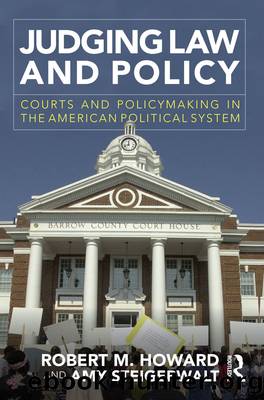Judging Law and Policy by Howard Robert M.; Steigerwalt Amy;

Author:Howard, Robert M.; Steigerwalt, Amy;
Language: eng
Format: epub
Publisher: Taylor & Francis Group
Figure 6.1 Ideology of Court and Congress, 1938â2010 and Major Civil Rights Cases
As one can see from Figure 6.1, the Court and the Congress were not that much out of ideological alignment during this period. For example, the Swann decision of 1971 mandating busing as a remedy for school desegregation was issued by a Supreme Court whose median ideology was actually more conservative than that of the Congress, ensuring that the Congress would not seek to overturn the decision. The Court therefore had some freedom to operate during this time frame and was generally pursuing policy supported byâor at least not out of sync withâthe elected branches of government.
4. Remedial Efforts to Achieve Equal Educational Opportunity
However, while the country was generally in line with the Court and agreed that racial discrimination should be outlawed, the remedies available to ban or change previous patterns of discrimination remained in dispute. For example, the Burger Court grew increasingly impatient with the slow pace of school desegregation, and placed increasing emphasis not on de jure law, but on de facto (i.e., in reality or fact) segregation. The continuing resistance to desegregation efforts, and the search for adequate remedies, led to the decision in Swann v. Charlotte Mecklenburg Board of Education (1971). In Swann, the Court addressed what remedies could be imposed on school districts in order to achieve the goal of creating unified school systems. The local district court judgeâwho, under Brown II was given the power to create and enforce desegregation schemesâproposed a plan involving forced busing, as well as widespread changes in administration, teachers, funding and other areas. The Supreme Court, in a unanimous decision, held that the use of mandated busing of school children to achieve racial balance, along with numerous other broad-scale remedies, was constitutional. In particular, the Court noted that â[o]nce a right and a violation have been shown, the scope of a district courtâs equitable powers to remedy past wrongs is broad, for breadth and flexibility are inherent in equitable remediesâ (15). In other words, the Courtâs decision stipulated that when a constitutional violation such as discrimination is found, courts then have the power to fashion remedies to correct the legal wrong. And when, as here, the scope of the violation is large, the scope of the remedy may be necessarily large as well.
Affirmative Action as a Viable Remedy for Educational Inequality
The Swann decision, as well as many of Brownâs progeny, was important because the Supreme Court reiterated that the judicial power of equity allows courts to remedy constitutional violations. However, the notion of courts intruding into local school board decision making provoked significant defiance and disapproval. Even today, so-called affirmative action programsâwhereby the government takes affirmative steps to remedy a constitutional violationâremain perhaps the most controversial aspect of equal protection analysis. Simply put, can the state take positive measures to remedy past de jure discrimination, such as requiring the admission or hiring of minorities previously discriminated against? In the words of President John F. Kennedy in Executive
Download
This site does not store any files on its server. We only index and link to content provided by other sites. Please contact the content providers to delete copyright contents if any and email us, we'll remove relevant links or contents immediately.
| Anthropology | Archaeology |
| Philosophy | Politics & Government |
| Social Sciences | Sociology |
| Women's Studies |
The Secret History by Donna Tartt(16606)
The Social Justice Warrior Handbook by Lisa De Pasquale(11485)
Thirteen Reasons Why by Jay Asher(7779)
This Is How You Lose Her by Junot Diaz(5753)
Weapons of Math Destruction by Cathy O'Neil(5027)
Zero to One by Peter Thiel(4816)
The Myth of the Strong Leader by Archie Brown(4785)
Promise Me, Dad by Joe Biden(4439)
Stone's Rules by Roger Stone(4410)
Beartown by Fredrik Backman(4399)
How Democracies Die by Steven Levitsky & Daniel Ziblatt(4392)
The Fire Next Time by James Baldwin(4336)
100 Deadly Skills by Clint Emerson(4070)
A Higher Loyalty: Truth, Lies, and Leadership by James Comey(4024)
Rise and Kill First by Ronen Bergman(4008)
The David Icke Guide to the Global Conspiracy (and how to end it) by David Icke(3875)
The Farm by Tom Rob Smith(3869)
Secrecy World by Jake Bernstein(3773)
The Doomsday Machine by Daniel Ellsberg(3725)
